Due to the dry air, the nose clogs up, there is a sore throat, a cough appears, the lips are cracked, hair becomes electrified, skin peels off... Agree, from such unpleasant phenomena you want to quickly get rid of?
Knowing how to humidify the air without a humidifier in the apartment, you will forget about these problems once and for all. Moreover, you will be able to maintain a comfortable microclimate in the house, regardless of the season and the weather outside the window.
In the article presented by us, you will find comprehensive answers to questions of interest to the caring owner of a house or apartment. We will tell you about the reasons for the decrease in humidity in confined spaces. We will show you how best to deal with low humidity and related phenomena.
The content of the article:
- Why is the air dry and humid?
- What is relative humidity?
- Relative humidity according to GOST
- Why is dry air harmful to humans?
- How to tell if the air is dry or not?
-
How to raise humidity correctly?
- Using utensils with water
- Moistening curtains and towels
- Plastic bottle and bandage
- Moisture-loving house plants
- Indoor table fountains
- Pebbles or expanded clay against dryness
- Filling the aqua soil in the container
- Aquarium with or without fish
- Steam from hot water
- Conclusions and useful video on the topic
Why is the air dry and humid?
A person breathes air, which contains water vapor. The actual amount of this vapor in one cubic meter of air is called absolute humidity. Abbreviated: ABB. For example, if one cubic meter of air contains 15 g of water, then the absolute humidity is 15 g / m3.
The amount of water in the air varies, but there is a maximum possible saturation of the air with water vapor at a given temperature. This value is called the maximum absolute humidity, saturation limit, or moisture capacity.
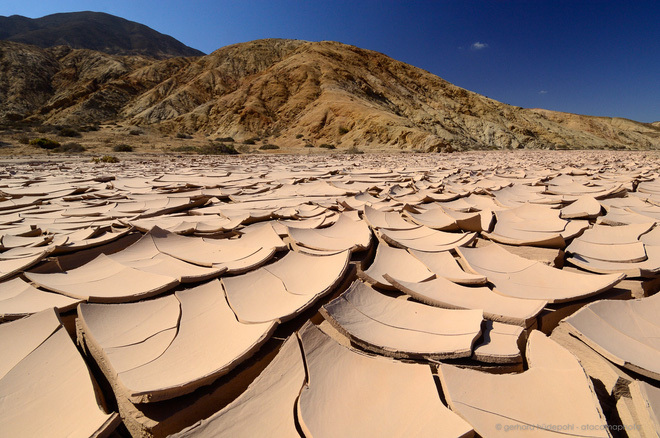
The lowest relative humidity on the planet is recorded in the Atacama Desert, on the Pacific coast of South America. Here it sometimes reaches record 0%
The moisture content of air depends on its temperature: the higher the temperature, the more water the air can hold. When the temperature drops, it passes the dew point and the air can no longer hold the same amount of water vapor.
"Excess" moisture condenses and falls out in the form of dew, frost or frost. As a result, the current absolute humidity decreases.
With an increase in temperature, the opposite process occurs - an increase in moisture capacity. In the presence of sources of water or steam, humidity will rise to the saturation limit characteristic of a given temperature.
What is relative humidity?
In weather forecasts, not absolute, but relative air humidity (RHM) appears. This is the ratio between the current and maximum absolute humidity multiplied by 100. It is not measured in grams per cubic meter, but as a percentage.
It is very important to understand that in winter, with the same ABB on the street and in the heated room, the AHV will be higher where the temperature is lower, that is, on the street.
Let's see how it looks in practice. At -20 ° С in 1 cubic meter of air there can be no more than 0.88 grams of water vapor. This is the saturation limit at which the relative humidity is 100%.
At +20 ° С, the amount of steam in one cubic meter of air can already reach 17.15 g / m3. With current ABB equal to 0.88 g / m3, RVV will be only 5.1%.

Map showing the relative humidity in different regions of Russia in winter, just find your location and find out how dry the air is outside the window
It would seem, why introduce two closely related concepts: relative and absolute humidity. But there are good reasons for this. Firstly, measuring HTS is much easier - even simple household hygrometers do an excellent job with this task.

The relative humidity of the air changes with the seasons, by comparing the two maps, you can find out how big the difference between winter and summer rates is.
And secondly (and most importantly), the degree of influence on the body is due to a combination of humidity and temperature, which means that the RHV indicator is more informative. Remember how uncomfortable it is on a hot day after rain, when the sauna effect occurs. With moderate humidity, heat is much easier to tolerate.
Relative humidity according to GOST
Options microclimate in living rooms are specified in GOST 30494-2011. They are classified as optimal and acceptable.
The microclimate is called optimal, in which the human body is able to maintain a normal thermal state without undue stress on the mechanisms of thermoregulation. With an optimal microclimate, about 80% of people in the room feel comfortable. But the remaining 20% will be uncomfortable.
With permissible microclimate parameters, the mechanisms of thermoregulation of the body are tense, due to which a person's well-being worsens, he feels discomfort, but without harm to health.
Let's clarify that these standards have been developed for builders and organizations serving residential buildings (ZhEKov, HOA, etc.). Therefore, the microclimate parameters are indicated in conjunction with the cold and warm seasons. That is, builders must build houses so that they keep heat and humidity at an acceptable level, and service organizations provide an adequate supply of heat in winter.
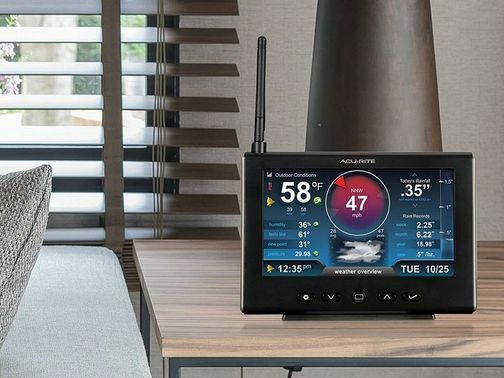
To obtain data on the level of humidity, a hygrometer is enough, but all parameters of the microclimate are important for health, a home weather station will help to control them
But for the human body, interrelated indicators of temperature and relative humidity are important, regardless of the season. What they should be shown in the table.
| Optimum air temperature | Optimum relative humidity | Maximum permissible relative humidity |
| 20-22 ° C | 45-30% | no more than 60% |
| 22-25 ° C | 60-30% | not more than 65% |
As you can see, the range of parameters is very wide and when the temperature rises by only 2-3 ° C, the upper limit of the optimum humidity immediately "jumps" up. It is clear that, despite the standards, an increase or decrease in humidity by 1.5-2 times at a constant temperature will affect health.
Even when approaching the lower limit of the norm, the air is perceived by many as too dry. If the temperature of -20 ° C and below is kept outside for a long period of time, the relative humidity in the apartments drops below the limit level and can reach 5-7%.
Why is dry air harmful to humans?
Muconasal secretion secreted by the mucous membranes of the nasal cavity acts as a barrier to the entry of viruses and bacteria dangerous to humans into the body.
With a lack of moisture in the air, the mucous membranes dry out, there is a lack of secretion, which contributes to infection with influenza and other infectious diseases. There is a runny nose, sneezing, coughing. From drying out and tension on the mucous membranes, microcracks are formed, which can become foci of purulent infections.
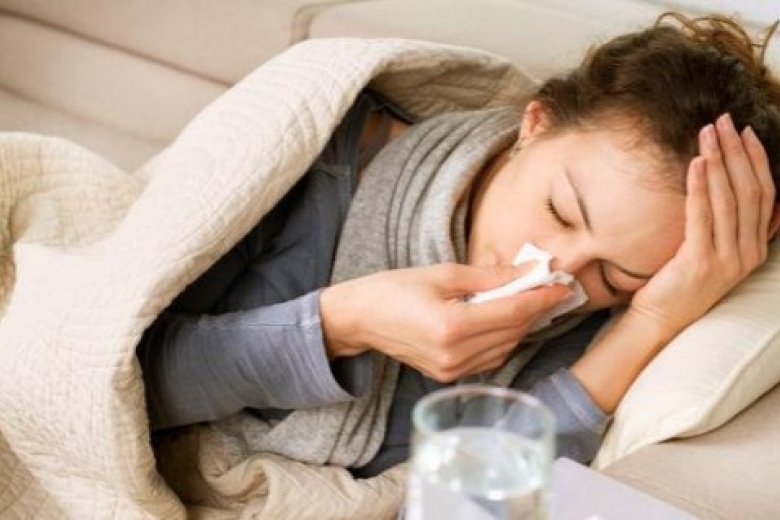
Overdried air negatively affects the mucous membranes, the inner nasal cavity suffers, the lips crack, general malaise occurs, the risk of ARVI increases
Being in a room with low humidity leads to rapid drying of tears. The surface of the eyes is not cleaned or wetted properly. Itching, redness appears. Most affected are people who work at a computer or wear contact lenses.
From dry air suffer not only mucous membranes, but also the skin. Dry skin is more prone to allergic reactions, dermatoses. The general state of health also deteriorates, the person gets tired faster, perceives information worse.
Young children are most sensitive to dry air. Doctors recommend maintaining a relative humidity of at least 45-50% in a nursery.
How to tell if the air is dry or not?
The easiest way to control the microclimate is with the help of instruments: a thermometer, hygrometer or home weather station. You can also use improvised means.
Fill a glass with water and place in the refrigerator to cool down to 3-5 ° C. Remove the glass of cold water and place it on a table or other surface for easy viewing.
After 10 minutes, assess the condition of the condensation on the outer wall of the glass. Small drops of water on a misted wall indicate normal humidity. Large drops flowing down the wall indicate high humidity. If there is no condensation, the outside of the glass is dry - the humidity is low.

An ordinary lump will help to approximately determine whether the air in the room is dry, open scales indicate the need to humidify the air
A fresh cone that has just been picked from a tree or has recently fallen off a branch reacts to the moisture content of the air. Introduced into an apartment where the air is too dry, it fully reveals its scales. On the other hand, at high humidity, the flakes will remain pressed. Just do not put the pine cone next to heat sources, otherwise the observation results will be unreliable.
It should also be remembered that the feeling of cold and warmth is purely individual. Someone even at 18 ° C walks around the house in one T-shirt. To others, district heating radiators seem cold, despite the optimal 22 ° C. Therefore, you need to focus on your own feelings and well-being.
But if there are the effects that were mentioned at the beginning of the article, while electric heaters are working, the apartment often ventilated when outside -10 ° C and below, and in houseplants, despite proper care, the tips of the leaves dry out - it's time act.
It is not necessary to buy special devices for this. It is well known how you can humidify an apartment in winter without a humidifier using folk methods, which at the same time have scientific justification.
How to raise humidity correctly?
Understanding the relative humidity under different conditions, you will no longer make a common mistake when trying to humidify an apartment by airing in winter. If it is frosty and high relative humidity outside, ventilation will have the opposite effect and the air will become even drier.
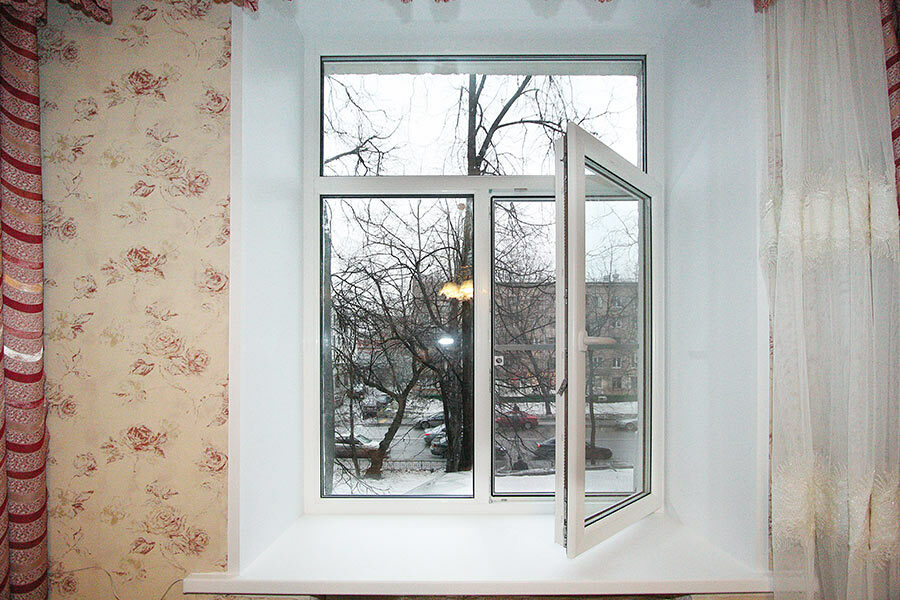
Ventilation at subzero temperatures does not help humidify the air, but dries it out, but it is necessary to ventilate the apartment for 5-10 minutes in the morning and evening to ensure air exchange
Also, do not reduce the heat supply or cover the battery with a blanket to reduce the temperature in the apartment. This will indeed increase the relative humidity, but the actual amount of moisture in the air will not change, even though this is exactly what our goal is.
It may seem that the limited moisture content of the air is only a nuisance. In fact, thanks to this property, the Earth's atmosphere saturated with water vapor does not boil and does not turn into an ice block, and to humidify too dry air in the apartment there is simple and effective methods.
Using utensils with water
On the seaside, there is always more moisture in the air, but it will not be possible to arrange a large reservoir in an apartment. But you can place containers with water in different places. As it evaporates, it will continuously humidify the air.
You can pour water into a basin, a tray for a refrigerator, a large dish, the main thing is that the evaporation surface is as large as possible. Bottles and other containers with narrow necks will not work for this purpose.
To avoid tripping over the dishes placed around the apartment, place them under the table, under the radiator, under the closet, or in other hard-to-reach places. Remember to top up the water as it evaporates.
Moistening curtains and towels
Heating radiators in standard apartments are located under the windows behind the curtains. Using a spray bottle, dampen the curtains with water until it is lightly damp. The heat from the battery will dry the fabric by evaporating the water. The method is most effective if heavy moisture-consuming curtains are used as curtains.

A moistened towel on a heating radiator remains one of the most popular ways to humidify the air; instead of terry towels, you can use another moisture-absorbing cloth.
Terry cloth, from which bath towels and bathrobes are sewn, absorbs and retains water well. Soak a terrycloth towel with water, wring it lightly and hang it over the back of a chair or radiator. After the towel dries, repeat the procedure.
Plastic bottle and bandage
You will need a 1 liter plastic bottle and a regular bandage 1-2 meters long. One end of the bandage is rolled up into a tourniquet and passed through the neck of the bottle to the very bottom. The bottle is filled with water and fixed to the battery, for example with a strong rope. The outer part of the bandage is wrapped around the battery.
The bandage will soak with water from the bottle and evaporate this moisture by the heat from the battery, humidifying the air. You just need to remember to add water to the bottle.
Moisture-loving house plants
Houseplants with large leaves retain a lot of liquid and moisturize the air well.
Best suited for this purpose:
- ficus and scindapsus;
- monstera and nephrolepis;
- aglonemma and diphenbachia;
- sansevieria and chlorophytum.
Moisture-loving plants require regular abundant watering and spraying.

Green friends of a person normalize the moisture content in the air and decorate the house, the larger the total surface of the green mass, the more moisture is released into the atmosphere
Wet potted soil will serve as another natural humidifier. In addition to humidification, plants purify the air from formaldehyde and other harmful substances, enrich it with oxygen.
Indoor table fountains
Small-sized tabletop indoor fountains can be with or without a submersible pump. The water rises and flows down, passing a path of varying difficulty and length.
During the circulation, natural evaporation of water occurs, due to which the air is saturated with moisture. These fountains are a fashionable decorative element. The murmur of jets promotes relaxation.
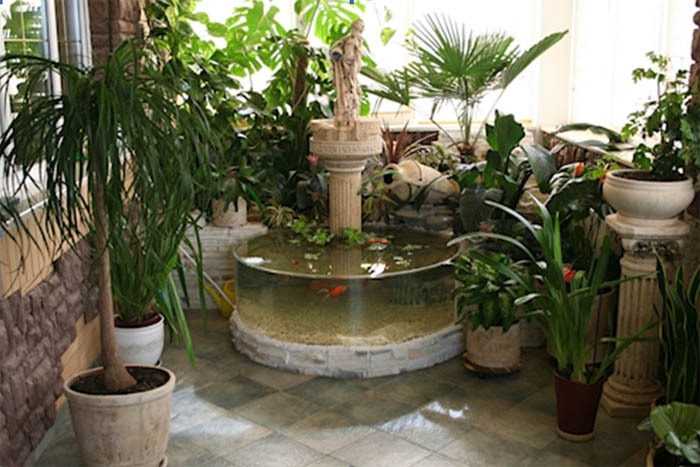
If space allows, allocate space for a composition of house plants, a floor fountain and an aquarium, this oasis will become a stable source of moisture and an original interior decoration.
Use distilled water to prevent limescale build-up. It must be refilled daily, preventing the fountain from running idle. Clean and flush the fountain every 1-2 months.
Pebbles or expanded clay against dryness
A wide, shallow container is filled half the height with small pebbles or expanded clay and water is poured, subsequently refilling it as it evaporates. On a pallet with pebbles, you can install pots with uzambar violets and place everything together on a windowsill or on a kitchen cabinet, if there is enough sunny place there.
The pebbles should be regularly washed under running water. It is also useful to periodically sterilize it by immersing it in boiling water for several minutes.
Filling the aqua soil in the container
Colored balls, which are able to absorb water, and then gradually give it to the soil or atmosphere, I call aqua soil. It is used in floriculture, adding to pots with houseplants. It also looks beautiful in vases with cut flowers.
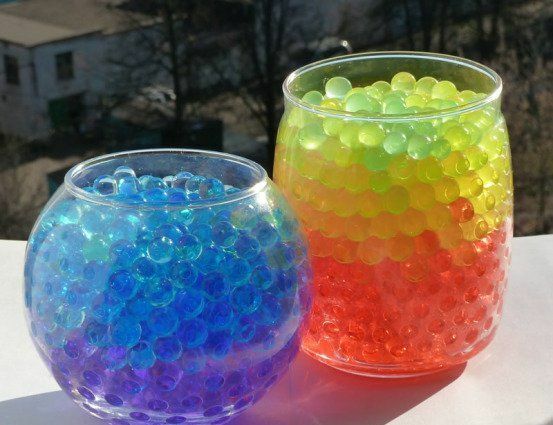
Colored balls of aqua soil are saturated with water, increasing in size, and then gradually release moisture into the air, requiring regular pouring of water
If you spread the aqua soil in vases and salanis, it will not only humidify the air in the apartment, but also decorate the interior. Stir the balls periodically so that not only the upper, but also the lower layer evaporates moisture, and add water. Shower balls once a week - rinse them under running water.
Aquarium with or without fish
Large and small transparent water tanks are great help in combating dry air. Table, floor, wall, round, rectangular, multifaceted aquariums are beautiful, fashionable and interesting.
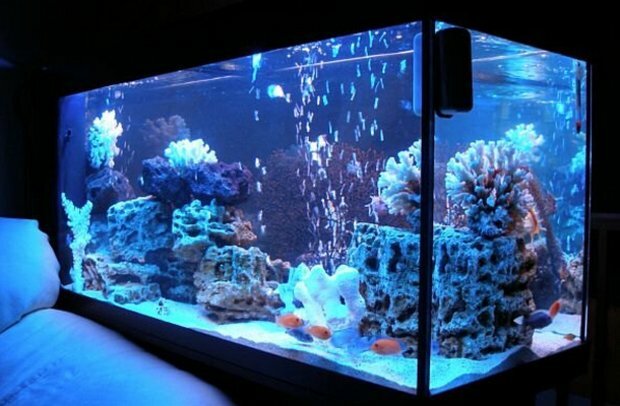
In the bedroom, a backlit aquarium will replace the night light and freshen the air; in the absence of marine life, it requires minimal maintenance
If you do not have the ability or desire to care for the inhabitants of your home reservoir, do without them. With such an aquarium, you do not have to waste time caring for fish and plants. For decoration, use colored soil, models of castles and coral reefs, do not forget about lighting. Do not cover the aquarium with a lid so that the water constantly saturates the air in the room with moisture.
Steam from hot water
There are situations when it is urgent to humidify the air. Boiling water in a kettle or open saucepan will quickly saturate the air with steam. This method can only be temporary, since it is easy to forget about the included stove. In order not to arrange a steam room in the kitchen, the fire under the pan should be minimal.
After taking a bath or shower, do not let moisture leave your apartment through the ventilation - open the bathroom door and let the air in the living rooms get saturated with moisture for a while.
Don't overdo it when dealing with dryness. Relative humidity above 70% will lead to dampness of the walls and ceiling, and this is already a favorable environment for the development of mold. Dampness in the house is much more dangerous to health, so avoid extremes and stick to the "golden mean".
If you consider the methods listed in the article not very effective and there is a desire to independently control the process of saturating the atmosphere in the room with water, it is worth purchasing humidifier, the features of the choice of which will be introduced by our article.
Conclusions and useful video on the topic
5 ways to increase air humidity in an apartment in practice:
How to effectively use a towel to combat excessive dryness in your home:
Air humidification, purification and aromatization:
The health and well-being of a person depends on the relative humidity of the air. In winter, the moisture content in the air can fall below the permissible standards, which requires the normalization of the microclimate. It is not necessary to use special devices for this.
You can get by with improvised means that have varying degrees of effectiveness. A combination of different methods helps to achieve a lasting effect and make your home more comfortable.
Do you have useful information on the topic of the article? Do you want to share it with site visitors? Write, comments, ask questions, post photos in the block form below.


